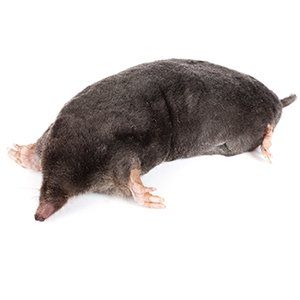Moles are insectivorous mammals that burrow underground in search of food such as earthworms, grubs, slugs, snails, ants, and other ground insects. They’ve even been known to eat small mice as well depending on the size of the mole. The most notable feature of moles is their paddle-like feet and prominent toenails that help them easily navigate through the soil. They have powerful legs and their fur is typically a grayish-brown to black in color with strands of silver.
Mole Control
Mole Removal & Extermination in mid-Missouri

The most common tell-tale sign of a mole problem is the evidence of their borrowing in your yard. You will notice turned up dirt on the surface of your lawn in tunnel-like formations, indicating exactly where they travel. If you notice these signs, it’s time to call Steve’s Pest Control. Continue reading for more facts about moles as well as how Steve’s Pest Control can eliminate your mole problem and restore your yard.
Where Can Moles Be Found?
The only species of mole found in and throughout Missouri is the eastern mole. These moles are comparable to the size of a chipmunk. They prefer the softer, moist ground of lawns, gardens, backyards, and woodland areas. They’ll typically stay away from hard or rocky areas because it is difficult for them to navigate through that kind of terrain. Moles have the ability to burrow up to 300 feet per day as they are active both day and night, only sleeping about 3 hours per day.
Damage Caused by Moles
The presence of moles on your property is more of a nuisance than anything else. Their underground tunnels can cause difficulty with lawn-mowing, and while they won’t eat bulbs or vegetation, their burrowing can cause grass and other plants to become disturbed, wither and die. The majority of the damage caused by moles is simply making an eyesore in your lawn as their hours of tunneling churn up the soil, giving your yard an uneven, patchy look. Moles also have to consume up to 80 percent of their body weight in food every day and can tunnel one foot per minute!
Mole Trapping and Removal Services by Steve’s Pest Control
Mole trapping is the most effective form of removing moles from your property because it ensures the moles are gone. The experts at Steve’s Pest Control will set proper traps and regularly walk through your property to check them. The traps set by Steve’s Pest Control will not incur any further damage to your property. While repellents or gasses may pose a cheaper option, they won’t guarantee mole eradication like we can. Let us handle your mole problem so you can get back to admiring your yard!
FAQ Residential Mole Pest Control: How to Get Rid of Moles
Addressing Mole Infestations through Pest Control
Q. Can Pest control get rid of moles and why are they a problem for homeowners?
A. Yes, pest control services effectively target moles in residential yards. Moles, known for their tunneling habits, can cause significant damage to landscaping, lawns, and gardens, disrupting the aesthetic and health of outdoor spaces.
Identifying Signs of Mole Activity
Q. How can I determine if I have a mole problem in my yard or garden?
A. Indicators of a mole problem include visible raised tunnels and mounds of soil, as well as root damage to plants in your lawn or garden.
Assessing the Harm and Disease Risk from Moles
Q. Are moles harmful, and can they transmit diseases to humans or pets?
A. While moles are not directly harmful to humans or pets and do not transmit diseases, their burrowing activity can significantly disrupt landscaping and garden structures.
Preventing Mole Infestations on Properties
Q. What attracts moles to my property, and how can I prevent mole infestations?
A. Moles are drawn to areas with rich soil containing earthworms and insects. Reducing soil moisture and removing food sources can help in preventing mole infestations.
Effective Mole Control Methods by Pest Professionals
Q. What methods do mole pest control services use to eliminate moles in residential settings?
A. Pest control services employ various techniques, including trapping, baiting, and fumigation, to effectively remove moles from residential areas.
Duration of Mole Removal Processes
Q. How long does it typically take to get rid of a mole infestation in my yard or garden?
A. The time to resolve a mole infestation depends on the infestation's extent and the removal method, but it generally takes a few weeks to achieve complete eradication.
Safety of Mole Control Methods
Q. Are the pesticides or traps used in mole control safe for children and pets?
A. Pest control experts use safe and approved methods for mole control. Traps and pesticides are typically placed in areas underground, minimizing exposure risks to children and pets.
Choosing Between DIY and Professional Mole Control
Q. Can I use DIY mole control products or should I hire a professional?
A. While DIY mole control options are available, professional pest control services tend to be more effective and efficient, particularly for larger or persistent mole issues.
Strategies to Deter Moles Post-Treatment
Q. How can I prevent moles from returning after removal?
A. To deter moles from returning, maintain a well-drained lawn, reduce excess soil moisture, and conduct regular inspections for early signs of mole activity.
Common Mole Varieties in Residential Areas
Q. Are there specific types of moles commonly found in residential settings, and how do they differ in behavior and appearance?
A. The Eastern mole is a frequently encountered species in residential areas. Pest control professionals can identify specific mole species and tailor their control strategies accordingly.
Contact Steve’s Pest Control for mole pest control today!

Steve’s Pest Control is a full-service pest control business run by a team of experts who are dedicated to taking care of your pest problems once and for all. We guarantee all of our pest control services with 100% customer satisfaction to ensure you are receiving the best.
Contact Information
© 2022 Steve's Pest Control. All Rights Reserved.
We will get back to you as soon as possible.
Please try again later.









